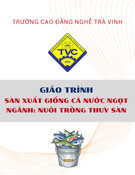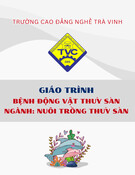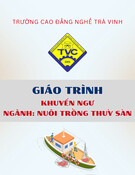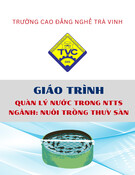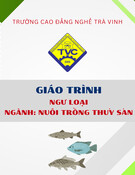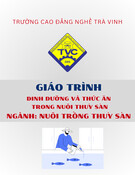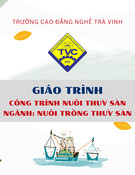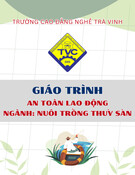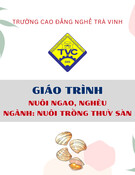
Vietnam Journal
of Agricultural
Sciences
ISSN 2588-1299
VJAS 2024; 7(3): 2217-2227
https://doi.org/10.31817/vjas.2024.7.3.04
2217
Vietnam Journal of Agricultural Sciences
Received: March 20, 2023
Accepted: August 23, 2024
Correspondence to
trungdq@dainam.edu.vn
ORCID
Do Quang Trung
https://orcid.org/0000-0001-5661-
4181
Enhancing the Growth Performance of
Whiteleg Shrimp, Litopenaeus vannamei, by
Salt-Tolerant Bacillus sp.
Do Quang Trung1* & Tran Thi Hang2
1Faculty of Pharmacy, Dai Nam University, Ha Noi 12100, Vietnam
2Faculty of Forestry, Vietnam National University of Forestry, Ha Noi 13400, Vietnam
Abstract
Probiotics are vital in aquaculture for maintaining water quality,
boosting aquatic species' health, and enhancing growth rates. This
study investigated the effects of probiotics, namely salt-tolerant
Bacillus velezensis MT50 and Bacillus amyloliquefaciens MT51, on
the water quality and performance of whiteleg shrimp (Litopenaeus
vannamei PL) cultured in tanks. The experimental design included
two bacterial treatments and one control treatment (without Bacillus),
with each treatment replicated three times. The results indicated that
temperature, pH, and total alkalinity varied within the ranges of 27.8
to 28.9°C, 7.81 to 7.94, and 98.5 to 114.7 mg CaCO3 L-1,
respectively, and all were maintained at appropriate levels.
Additionally, other parameters such as dissolved oxygen (DO),
chemical oxygen demand (COD), total suspended solids (TSS), and
total ammonia nitrogen (TAN) exhibited less fluctuation in the
treatments supplemented with Bacillus sp. compared to the control.
Furthermore, the densities of pathogenic agents (e.g., Vibrio) in tanks
with the addition of MT50 and MT51 bacteria (102 and 101 CFU mL-
1, respectively) were significantly lower than in the control tanks (104
CFU mL-1). The survival rates of shrimp treated with MT50 (70.0 ±
5.3%) and MT51 (86.7 ± 3.1%) were significantly higher (P <0.05)
compared to the control group (65.3 ± 3.1%). These findings suggest
the potential application of B. velezensis MT50 and B.
amyloliquefaciens MT51 as probiotics for sustainable aquaculture
practices.
Keywords
Bacillus, Litopenaeus vannamei, probiotics, Vibrio, water
quality
Introduction
The seafood industry in Vietnam, particularly in Nam Dinh, is
experiencing significant development due to various investment
opportunities. However, recent years have seen disease outbreaks in

Enhancing the growth performance of whiteleg shrimp, Litopenaeus vannamei, by salt-tolerant Bacillus sp.
2218
Vietnam Journal of Agricultural Sciences
aquatic animals due to intensive high-density
farming and erratic climate conditions.
Furthermore, water quality and the cultural
environment have suffered from pollution, which
has adversely affected production. The frequent
and improper use of antibiotics to treat aquatic
diseases has led to the emergence of antibiotic-
resistant bacterial strains (Rupasinghe et al.,
2024). The global increase in chemical usage
across various industries is impacting human
health, prompting a growing interest in replacing
harmful chemicals with environmentally friendly
alternatives. Consequently, there is a pressing
need for solutions to enhance the quality of the
cultural environment without harming aquatic
animals or humans (Cabello et al., 2013;
Madhana et al., 2021; Mondal et al.,
2022).Currently, the application of beneficial
microorganisms, known as probiotics, in
aquaculture is a widely adopted solution to
address these challenges. According to
Onianwah (2018), sustainable aquaculture
systems require the presence of beneficial
bacteria. Several species of probiotic microbes,
such as Bacillus subtilis, B. licheniformis, B.
megaterium, Nitrobacter sp., Nitrosomonas sp.,
Lactobacillus plantarum, and L. fermentum, have
been utilized (Butt et al., 2021). These bacteria
are non-toxic, have no side effects, do not persist
in the environment, and are not resistant to
antibiotics. They are effective in improving the
environment, boosting the immune systems of
aquatic animals, reducing stress, and maintaining
the equilibrium of the aquatic ecosystem
(Hoseinifar et al., 2018; Madhana et al., 2021).
Bacteria play a crucial role in producing
bioactive compounds, and Bacillus strains are
particularly known for degrading organic
compounds in soil and water through their
biological activities. Enzymes such as protease,
amylase, and cellulase contribute to closing the
material cycle in nature (Madhana et al., 2021).
This capability is also leveraged in waste
processing and decomposition.
Throughout their lifecycle, bacteria secrete
numerous biologically active substances that can
resist various microbial species, including fungi
and bacteria. Our previous study showed that two
Bacillus strains, MT50 and MT51, exhibited high
efficiency in ammonium removal, and optimally
thrived at pH 7 and in high salinity conditions
(4% NaCl). Laboratory tests on their capability
to improve shrimp aquaculture wastewater
revealed that the two Bacillus strains removed
72.25% and 78.85% of the ammonium by the
seventh day, respectively. Notably, strain MT50,
when combined with unsterilized shrimp
wastewater, demonstrated the highest
ammonium removal efficiency of 79.91% with a
1% cell suspension by the fourth day.
Additionally, the experiment showed the
production of nitrite and nitrate, which were
subsequently removed by the selected Bacillus
species. These findings suggest that the two
isolated Bacillus strains could be utilized as
heterotrophic nitrification-aerobic denitrification
species. Thus, developing new methods of using
these two bacterial strains with high adaptability
for aquaculture applications is essential.
Materials and Methods
Shrimp aquaculture water preparation
The seawater source with a salinity of 30‰,
obtained from Xuan Thuy, Nam Dinh, was
mixed with tap water to achieve a final salinity of
16‰. This water was then treated with chlorine
at a concentration of 30mg L-1, followed by
adding Na2S2O3 to neutralize any excess
chlorine, and aerated for approximately 12-24
hours. One hundred-liter composite tanks,
prepared for the experiment, were placed in a
closed room (room temperature was kept at
25°C) and arranged according to an open system
with continuous aeration. Before the experiment,
each tank was disinfected with chlorine at a
concentration of 30ppm for 30 minutes to
prevent bacterial contamination.
Preparation of the two endophytic Bacillus
inoculants
The two ammonia-oxidizing endophytic
bacteria used in this study, Bacillus velezensis
MT50 (MT50) and Bacillus amyloliquefaciens
MT51 (MT51), were isolated from Man Trau
grass (Eleusine indica) collected from shrimp
farms in Binh Thuan (Trung et al., 2022). These
Bacillus strains have demonstrated salt tolerance

Do Quang Trung & Tran Thi Hang (2024)
https://vjas.vnua.edu.vn/
2219
and ammonium removal capabilities in
synthesized shrimp aquaculture wastewater. The
strains were initially cultured in LB media and
then proliferated in liquid LB media. Following
proliferative culture, the bacterial cells were
collected via centrifugation, and resuspended in
sterile water, and their density was determined by
measuring the optical density (OD) at a
wavelength of 600nm on a UV/Vis
spectrophotometer (Spectroquant®Prove 300,
Merck, Germany).
Evaluation of the effects of the Bacillus
inoculants on the shrimp culture water quality
Whiteleg shrimp (Litopenaeus vannamei PL
9) were used in the experiment. The shrimp were
kept in a tank for 30 days until they reached an
average weight of 1g. Before the experiment, 20
shrimp were measured and weighed. The shrimp
were stocked at a density of approximately 0.5
shrimp per liter (500 shrimp m-3).
The experiment consisted of three
treatments: T1 (Control), with no addition of
bacterial culture; T2, with the addition of
Bacillus velezensis MT50; and T3, with the
addition of Bacillus amyloliquefaciens MT51.
The optical density (OD) of the bacterial cultures
was 106 CFU mL-1. The experiment was
conducted in 100-L composite tanks filled with
100L of prepared saline water (salinity of 16‰,
pH 7.5) as described above. The treatments were
arranged in a completely randomized design and
repeated three times at room temperature (25°C).
Shrimp were fed with Grow Feed four times
a day at 06:00, 11:00, 16:00, and 21:00. The
sediment was siphoned out of each tank twice
daily, in the morning and the afternoon, and
aeration was continuous. Throughout the
experimental procedure, the water was not
replaced but was instead replenished to
compensate for the volume siphoned. The
duration of the experiment was 60 days.
Throughout the experiment, water quality
indicators (temperature, pH, total soluble solids
(TSS), chemical oxygen demand (COD), total
ammonia nitrogen (TAN), and total alkalinity),
shrimp survival rate, and bacterial density were
monitored. Water samples were collected 20-30
cm below the water surface, refrigerated at 4°C,
and analyzed within two hours. pH and
temperature were measured twice daily (at 06:00
and 15:00) using a Milwaukee Mi805 Portable
pH/EC/TDS/Temperature Meter (Mi805
Milwaukee, CO, USA).
TSS, COD, TAN, and alkalinity were
checked every five days using the detergent
solution provided with a multi-parameter
photometer (HI83399-02, Hana, Romania) as per
the manufacturer's instructions. After each test, if
the total alkalinity was low, NaHCO3 was used
to stabilize the alkalinity levels.
Bacterial samples were collected before the
addition of bacteria and every five days thereafter
until the end of the experiment. Bacterial density
was determined by the colony counting method
(Jett, 1997). The density of Vibrio spp. was
determined by the colony counting method on
Thiosulfate Citrate Bile Salts Sucrose (TCBS)
selective agar medium (Merck, Germany),
incubated at 30ºC for 24 hours. For the total
number, density was measured by counting
colonies on Nutrient Agar medium (Merck,
Germany), incubated at 30ºC for 48 hours.
Bacillus spp. was confirmed by Gram-positive
and catalase-positive tests.
The following formula was used to calculate
the growth rate in terms of shrimp length:
Growth rate in length (%) = [(Lf – Li)/Li] ×
100
where Li is the length of 20 shrimp at the
beginning of the experiment (cm) and Lf is the
length of 20 shrimp at the end of the experiment
(cm).
The following formula was used to calculate
the shrimp weight:
Weight gain (g) = Wf – Wi
where Wi is the weight of 20 shrimp before
the experiment (g) and Wf is the weight of 20
shrimp at the end of the experiment (g).
The survival rate of the shrimp was
determined at the end of the experiment using the
formula:
Survival rate (%) = (Final numbers/Initial
numbers) × 100
Daily weight gain (g day-1) = (Final weight –
Initial weight)/number of days

Enhancing the growth performance of whiteleg shrimp, Litopenaeus vannamei, by salt-tolerant Bacillus sp.
2220
Vietnam Journal of Agricultural Sciences
Specific growth rate (% day-1) = ([ln(final
wt) – ln(initial wt)]/number of days) × 100
Statistical analysis
The data were calculated and statistically
described using Excel software. The data were
compared via single-factor ANOVA statistics and
the DUNCAN test using SPSS version 16.0. The
level of statistical significance was set at 0.05.
Results and Discussion
Temperature of water
In this study, the water temperature in the
treatments ranged from 27.8 to 28.9°C (Table 1),
which were quite similar to the initial
temperature (27.47°C) and were within the
suitable range for shrimp farming as reported by
Whetstone et al. (2002) and Boyd et al. (2002).
Previous research has shown that P. vannamei is
able to tolerate a wide range of temperatures,
from 7.5 to 42.0°C, with optimal temperatures
being 30°C for smaller shrimp and 27°C for
larger shrimp (Millard et al., 2020). The findings
of this study aligned with these reported data.
pH of water
Overall, the pH of the water in the treatments
exhibited minimal fluctuations compared to the
initial pH (7.5), with a slight increase observed
mid-experiment. This increase could be
attributed to the accumulation of organic matter
from leftover feed and shrimp manure, as well as
fluctuations in the dissolved oxygen (DO)
content. Notably, pH variation ranged from 7.80
to 7.95 in the experimental groups (Table 1),
with morning values ranging from 7.80 to 7.85
and afternoon values from 7.90 to 7.95.
According to Chanratchakool et al. (1995), pond
pH is crucial as it directly or indirectly affects
shrimp development, with the optimal range for
shrimp growth being 7.8 to 8.2. Additionally,
Briggs & Funge-Smith (1994) reported that a pH
of 7.5-8.5 was ideal for the growth of nitrifying
bacteria. Therefore, the pH levels in this study
were suitable for shrimp growth.
Total alkalinity
The alkalinity in the treatments ranged from
98.43-115.01 mg CaCO3 L-1 (Figure 1).
Specifically, in the non-bacterial treatment (T1),
total alkalinity ranged between 98.43-114.12 mg
CaCO3 L-1. In the groups supplemented with
Bacillus MT50 (T2) and Bacillus MT51 (T3), the
alkalinity ranged from 98.1-114.03 mg CaCO3
L-1, and 98.2-114.05 mg CaCO3 L-1,
respectively. The treatments were not
statistically different (P >0.05).
The observed increase in alkalinity during
the experiment can be attributed to the
maintenance of stable alkalinity levels by adding
CaCO3 to the culture tanks. According to Tran
Ngoc Hai et al. (2004), the optimal alkalinity for
shrimp growth is between 80 and 120 mg L-1.
These results demonstrate that the alkalinity
levels across the tanks were consistent and within
the optimal range for shrimp growth.
Total suspended solids (TSS)
The findings revealed a gradual increase in
total suspended solids (TSS) throughout the
culture period, peaking at 392.01 mg L-1 (Figure
2). Additionally, TSS exhibited fluctuations in
the T1, T2, and T3 treatments, ranging from
18.37 to 392.01 mg L-1, 20.01 to 304.37mg L-1,
and 19.34 to 302.19 mg L-1, respectively.
Particularly, T3 demonstrated significantly lower
TSS levels compared to T2 (P <0.05).
Table 1. Mean water temperature and pH of treated shrimp aquaculture water collected from the different experimental groups after
60 days.
Parameters
T1
T2
T3
Temperature (°C)
27.8 c
28.16 a
28.9 a
pH
7.80 c
7.81a
7.95 a
Note: Data presented as mean
.
Values in the same row with different letters are statistically different (P <0.01). T1: shrimp culture with
no addition of bacteria culture, T2: shrimp culture with the addition of Bacillus velezensis MT50, and T3: shrimp culture with the
addition of Bacillus amyloliquefaciens MT51.

Do Quang Trung & Tran Thi Hang (2024)
https://vjas.vnua.edu.vn/
2221
Note: T1: shrimp culture with no addition of bacteria culture, T2: shrimp culture with the addition of Bacillus velezensis MT50, and T3:
shrimp culture with the addition of Bacillus amyloliquefaciens MT51.
Figure 1.
Fluctuation in total alkalinity among the different experimental groups for 60 days
Note: T1: shrimp culture with no addition of bacteria culture, T2: shrimp culture with the addition of Bacillus velezensis MT50, and T3:
shrimp culture with the addition of Bacillus amyloliquefaciens MT51.
Figure 2.
Fluctuations in total suspended solids among the different experimental groups for 60 days
In another study by Pham et al. (2011),
shrimp cultured in tanks exhibited TSS levels
comparable to those observed in our study (384
mg L-1). In contrast, shrimp cultured in ponds
without beneficial bacterial additions, as reported
by Nguyen & Vo (2008), showed much higher
TSS accumulation (746 mg L-1). Our findings
indicate a consistent rise in TSS, with the highest
recorded value of 390 mg L-1 observed in the
control group. Furthermore, our data
underscored a notable decrease in TSS levels in
tanks supplemented with Bacillus bacteria. This
reduction can be attributed to the effective
breakdown of organic compounds by the MT51

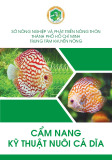

![Kỹ thuật nuôi thâm canh cá lóc trong ao đất: Tài liệu [chuẩn/mới nhất]](https://cdn.tailieu.vn/images/document/thumbnail/2025/20250724/kimphuong1001/135x160/3731753342195.jpg)



![Kỹ thuật nuôi cá nâu trong ao đất: Tài liệu [Mới nhất]](https://cdn.tailieu.vn/images/document/thumbnail/2025/20250723/vijiraiya/135x160/29781753257641.jpg)
![Kỹ thuật nuôi cá mú trong ao đất: Tài liệu [Mới nhất]](https://cdn.tailieu.vn/images/document/thumbnail/2025/20250723/vijiraiya/135x160/85681753257642.jpg)

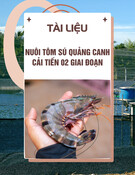
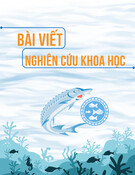
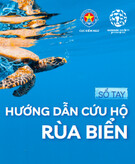
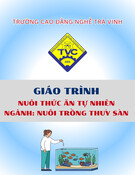
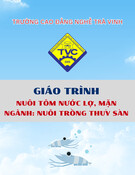
![Giáo trình Sản xuất giống tôm nước lợ, mặn (Trung cấp/Cao đẳng) - Trường Cao đẳng nghề Trà Vinh [Mới nhất]](https://cdn.tailieu.vn/images/document/thumbnail/2025/20251115/kimphuong1001/135x160/76031763179346.jpg)

